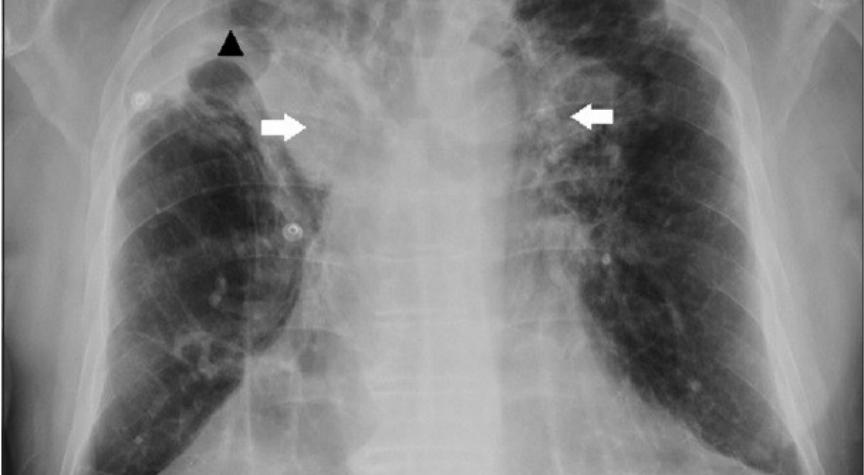
- •Purulent diseases of lungs and pleura
- •Lung abscesses
- •Factors contributing to lung abscess
- •Factors contributing to lung abscess -2
- •Lung abscessess classification
- •Classification According to the character of purulent process:
- •Classification According to stages:
- •Classification Complications:
- •Symptomatology
- •Clinical manifistation of the first stage of acute abscess
- •Clinical manifistation of the second stage
- •Clinical manifestation at the third stage
- •Diagnostic procedures
- •Instrumental methods
- •X-ray examination
- •X-ray –frontal and lateral exam (2 plains)
- •Chronic abscesses
- •X-Ray chronic abscess
- •Lung gangrene
- •Differential diagnosis with Lung Carcinoma
- •The tactics in acute pulmonary destruction
- •Tactics:
- •Surgery, indications
- •Operations
- •Lateral thoracotomy
- •Posterolateral thoracotomy
- •Anterior thoracotomy
- •Pleural empyema
- •Etiology and pathogenesis
- •Classification (1)
- •Classification (2)
- •Classification (3)
- •Classification (4)
- •Symptomatology
- •Symptoms-1
- •Symptoms-2
- •Examination
- •X-ray examination
- •The diagnostic program
- •Chest X-ray presentation of pleural empyema
- •Pleural puncture
- •Local anestesia
- •Needle Positioning
- •Tactics and choice of treatment
- •Pleural drainage
- •Tactics and choice of treatment
- •surgery
- •Mediastinitis
- •Etiology
- •Mediastinitis originating from structures within the mediastinum
- •Descending necrotising mediastinitis
- •Symptoms
- •Investigations
- •X-ray examination
- •CT scans
- •Management
- •surgery
- •Prognosis
Mediastinitis originating from structures within the mediastinum
•Oesophageal rupture is the most common cause of mediastinitis.
•This may be due to:Foreign body ingestion.
•Spontaneous oesophageal rupture.
•Local neoplastic spread.
•Iatrogenic causes including:
–Endotracheal intubation.
–Bronchoscopy.
–Cardiothoracic surgery (most cases of mediastinitis in the developed world follow cardiothoracic surgery).
–Upper gastrointestinal (GI) endoscopy.
Descending necrotising mediastinitis
•This may originate from:
•Pharyngitis.
•Tonsillitis, peritonsillar abscess and parapharyngeal abscess.
•Otitis media.
•Sinusitis.
•Dental abscess. Sialadenitis.
•Infection after head and neck surgery
Symptoms
•Fever and/or rigors can occur.
•Shortness of breath may be present.
•Retrosternal chest pain, usually described as pleuritic, may radiate to the neck or back.
•There may be a sensation of soreness or congestion in the neck if the condition is due to descending infection.
•The patient may notice that their neck is swollen.
•Confusion or disorientation may be present due to the onset of systemic sepsis.
Investigations
•FBC: white cell count is usually elevated.
•Blood cultures should be taken.
•Swabs of any obvious sources of sepsis in the mouth or neck tissues should be taken.
•X-ray of the neck and chest may show widening of the pre-cervical, retropharyngeal and paratracheal soft tissues. Pneumomediastinum and air-fluid levels may be seen
•Mediastinal widening may be seen but is not a reliable sign.

X-ray examination

CT scans
Management
•Initial management should focus on resuscitation, including protecting the airway, maintaining adequate oxygenation with supplementary oxygen,
•High-dose broad-spectrum intravenous antibiotics should be started as soon as possible.
surgery
•Surgery usually consists of urgent thoracotomy or access via a cervical approach.
•Drainage of pus and necrotic material with tissue debridement is carried out
•as well as closure of any oesophageal rupture, or drainage of any cervical infective focus
Prognosis
•In the presence of comorbid conditions, the mortality rate may be as high as 67%.
•descending necrotising mediastinitis in the last decade indicate mortality rates ranging between 11.1-34.9%.
•High clinical suspicion in susceptible individuals, early diagnosis and prompt aggressive management are the best way to reduce morbidity and mortality

